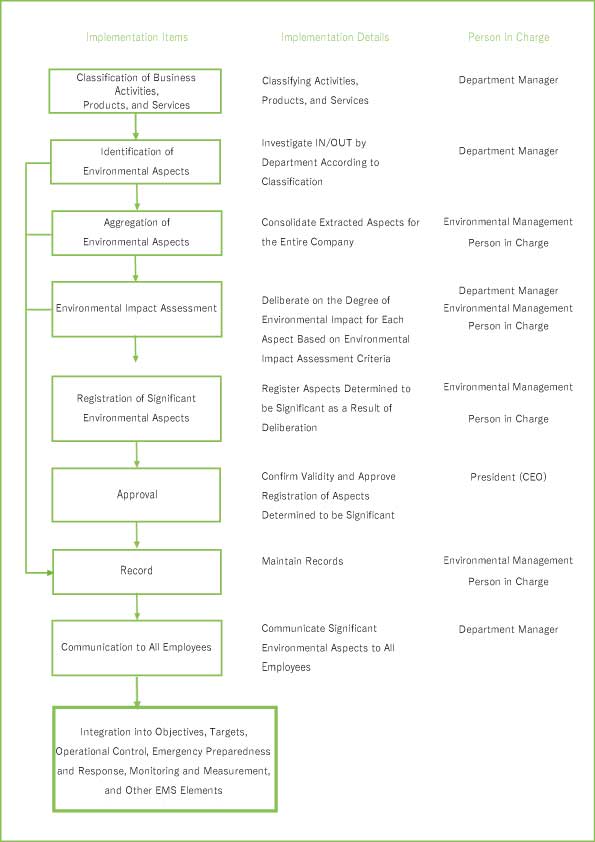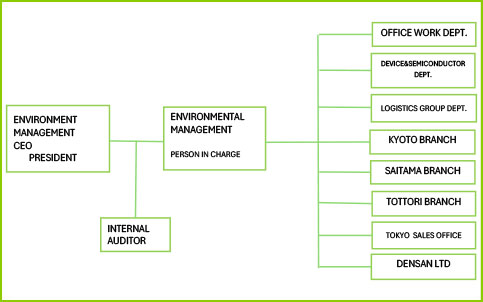We report on our environmental conservation efforts
Fuji Electric Industry Co., Ltd. and Densan Co., Ltd. will establish and maintain an environmental management system compliant with ISO 14001. This system is designed to evaluate the environmental impacts of their business activities, products, and services, and to set environmental objectives and targets based on their environmental policy and environmental impact assessment (significant environmental aspects), ensuring conformity with these requirements.
Education and Training ISO 14001
Philosophy
Fuji Electric Industry Co., Ltd. and Densan Co., Ltd. conduct their corporate activities with the recognition that the preservation of the global environment is one of humanity's most crucial shared challenges.
Policy
Fuji Electric Industry Co., Ltd. and Densan Co., Ltd., through their procurement and sale of electrical/electronic components and office equipment, as well as telecommunication construction work, aim to minimize the environmental impact of their activities, products, and services under the slogan "Harmony with the Global Environment." As companies that prioritize environmental considerations, especially given their office locations in central urban areas, they will implement the following principles:
- All employees will unite to recognize the importance of environmental preservation and conduct business activities accordingly.
- They will conduct environmental impact assessments to accurately understand the effects their business activities, products, and services have on the environment. Based on these assessments, they will establish environmental objectives and targets, review them regularly, and strive for the continuous improvement of their environmental management system and performance.
- They will comply with environmental laws, regulations, and other requirements applicable to their company.
- They will contribute to global environmental preservation by promptly investigating with manufacturers regarding the environmental load and chemical content of products delivered to customers and providing replies.
- Considering the environmental impact generated by business activities, products, and services, they will work towards pollution prevention, with the following items as key priorities for all employees:
- Accurately convey information related to social and customer environmental preservation needs to manufacturers, request the development of products with lower environmental impact, and cooperate in eco-product development
- Reduce energy consumption, primarily electricity used in offices and sales activities, and gasoline consumption, to prevent global warming and resource depletion.
- Reduce waste emissions through effective resource utilization and the promotion of recycling.
- Improve operational efficiency and eliminate waste to reduce the consumption of resources, mainly copy paper.
- They will appoint internal auditors, conduct environmental audits based on an annual plan, review the environmental management system and performance, and strive for continuous improvement.
- They will provide environmental education to all employees, thoroughly disseminate the environmental policy and environmental management system, and aim to raise environmental awareness. They will also seek understanding and cooperation from related parties, including business partners.
- All employees will engage with their own families and local communities to foster increased environmental awareness and promote its implementation.
Environmental Impact Flow ISO 14001

Education and Training ISO 14001
The Environmental Management Representative will ensure that the company's environmental management activities are reliably implemented by conducting education and training to guarantee competence.
1.Types, Contents, Responsible Personnel, and Participants of Education and Training
The types, contents, and participants of education and training provided by our company are as follows:
| 1. General Education |
1. The importance of conforming to the environmental policy, procedures, and management system requirements.
2. The significant environmental aspects associated with one's work and the related actual or potential environmental impacts, as well as the environmental benefits from individual work improvements.
3. Roles and responsibilities for achieving conformity with environmental management system requirements.
4. The anticipated consequences of deviating from prescribed procedures. |
Environmental Management Representative or Department Manager |
All relevant personnel |
| 2. Specific Worker Education |
There are no workers performing tasks that cause significant environmental impacts (e.g., handling hazardous materials or chemical substances). However, since nearly all personnel are involved in tasks related to significant environmental aspects, this training will be conducted as part of General Education. |
|
|
| 3. Internal Auditor Education |
Necessary education for conducting internal audits:
1. ISO 14001 Standard
2. Environmental laws and other requirements
3. Audit practical training
4. Other |
External Training Institutions or individuals who have completed external courses |
Internal auditors |
| 4. Supplier Representatives |
Similar to General Education; for the time being, the company's environmental policy will be distributed, and their cooperation will be requested. |
Environmental Management Representative |
Responsible persons at business partners |
2. Education and Training Plan
Education and training will be conducted annually in May. However, for new employees joining the company, the Department Manager will conduct ad-hoc training within three months of their start date. For absentees, materials will be distributed, and their understanding will be confirmed via a report.
Environmental Objectives and Targets Operational Procedure ISO 14001
To achieve or mitigate the "Environmental Objectives and Targets," "Significant Environmental Aspects," "Legal and Other Requirements," and "Requests to Suppliers and Procurement of Goods Used by Our Company," which have been established for the execution of our Environmental Policy, we will maintain the operational procedures defined below. These procedures will clearly define operational criteria.
Key items stipulated in the Environmental Objectives and Targets will be implemented in accordance with the Environmental Management Program. However, procedures already in effect will be documented and clarified below.
- Request for ECO-Friendly Product Development to Manufacturers (All Departments Except Administration)
- Transmit information related to social and customer environmental preservation needs to manufacturers.
- Request a reduction in product power consumption.
- Request an increase in product recycling rates.
- Request a reduction in packaging materials.
- Reduction of Gasoline Consumption (All Departments)
- Avoid unnecessary idling.
- Avoid sudden acceleration and sudden braking.
- Comply with legal speed limits and also consider economical driving speeds.
- Each person should plan efficient routes when visiting customers.
- Reduction of Waste Emissions (All Departments)
- Avoid creating dead stock (which becomes industrial waste).
- Thoroughly sort waste to improve the recycling rate (sorting criteria will be posted at the waste storage area).
- Do not acquire unnecessary books or catalogs.
- Encourage the use of electronic communication methods like email.
Other Activities Related to Significant Environmental Aspects
- Electricity Consumption Reduction (All Departments)
- Thoroughly manage air conditioning temperature settings (26°C for cooling, 22°C for heating).
- Ensure unnecessary lights are turned off.
- Turn off unused office automation (OA) equipment.
- Copy Paper Usage Reduction (All Departments)
- Copy Paper Usage Reduction (All Departments)
- Utilize electronic documents.
- Promote double-sided copying.
- Packaging Material Usage Reduction (All Departments)
- Reuse used packaging materials.
- Promote the use of returnable containers.
Environmental Management System Organization Chart ISO 14001
Implementation and Operation
Resources, Roles, Responsibilities, and Authority
The organization for the Environmental Management System is shown in Figure 4.4.1-1
